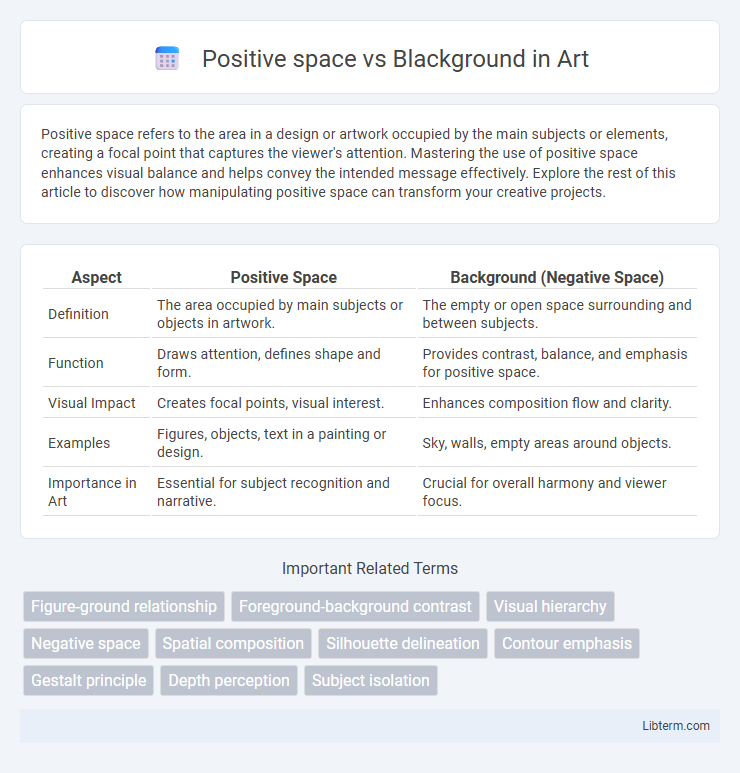Positive space refers to the area in a design or artwork occupied by the main subjects or elements, creating a focal point that captures the viewer's attention. Mastering the use of positive space enhances visual balance and helps convey the intended message effectively. Explore the rest of this article to discover how manipulating positive space can transform your creative projects.
Table of Comparison
| Aspect | Positive Space | Background (Negative Space) |
|---|---|---|
| Definition | The area occupied by main subjects or objects in artwork. | The empty or open space surrounding and between subjects. |
| Function | Draws attention, defines shape and form. | Provides contrast, balance, and emphasis for positive space. |
| Visual Impact | Creates focal points, visual interest. | Enhances composition flow and clarity. |
| Examples | Figures, objects, text in a painting or design. | Sky, walls, empty areas around objects. |
| Importance in Art | Essential for subject recognition and narrative. | Crucial for overall harmony and viewer focus. |
Understanding Positive Space and Background
Positive space refers to the main subjects or objects in a composition that attract the viewer's attention, while the background consists of the surrounding area that supports and enhances these elements without overpowering them. Understanding the balance and interaction between positive space and background is crucial for creating depth, emphasis, and visual harmony in art and design. Effective use of background helps define the boundaries of positive space, contributing to better perception and aesthetic appeal.
Key Differences between Positive Space and Background
Positive space refers to the main subjects or focal elements in a composition, while the background is the area surrounding and behind those subjects. The key difference lies in their function: positive space captures viewer attention by defining shapes and forms, whereas the background provides context, contrast, and visual balance. Effective design utilizes the interplay between positive space and background to create depth and emphasize the intended message.
The Role of Positive Space in Visual Composition
Positive space defines the main subjects in a visual composition, creating focal points that guide the viewer's attention and establish hierarchy. Effective use of positive space enhances clarity and balance, allowing objects to interact meaningfully within the frame. This deliberate allocation shapes perception, emphasizing key elements while contributing to overall aesthetic harmony.
How Background Influences Perception
Background significantly shapes perception by providing context and contrast that enhance the visibility and meaning of positive space in visual compositions. A well-chosen background creates depth and directs focus, influencing how viewers interpret shapes, colors, and spatial relationships within an image. Subtle background hues and textures can evoke emotions and highlight the primary subject, thereby altering the overall aesthetic and cognitive response.
Balancing Positive Space and Background in Design
Balancing positive space and background in design enhances visual harmony by ensuring focal elements do not overwhelm or get lost within the composition. Effective use of positive space highlights key subjects, while thoughtful background management creates contrast and depth, improving readability and user engagement. Designers optimize spatial relationships by adjusting size, shape, and color contrast to maintain equilibrium between positive space and background.
Techniques to Highlight Positive Space
Techniques to highlight positive space include using contrast, color differentiation, and precise edge definition to draw attention to the main subject within a composition. Employing lighting effects and focus adjustments can create depth, emphasizing the positive space against the background. Strategic use of texture and negative space manipulation further enhances the prominence of the positive space, guiding the viewer's eye to the intended focal point.
Creative Uses of Backgrounds in Art and Design
Positive space refers to the main subjects or elements in an artwork, while the background provides the negative space that surrounds and complements them. Creative uses of backgrounds in art and design include incorporating textured patterns, varying color contrasts, and utilizing abstract or minimalistic elements to enhance depth and focus. Artists often manipulate backgrounds to evoke mood, guide the viewer's eye, or create visual harmony, making the interplay between positive space and background essential for dynamic compositions.
Common Mistakes with Positive Space and Background
Common mistakes with positive space and background often involve neglecting the balance between the two, causing the composition to feel cluttered or confusing. Designers frequently overlook the importance of clear delineation, resulting in positive space blending into the background, which diminishes visual impact. Failure to manage contrast and alignment can lead to a loss of depth and hierarchy, weakening the overall message conveyed by the design.
Case Studies: Effective Use of Space in Visual Media
Case studies in visual media demonstrate that effective use of positive space--the areas occupied by main subjects--creates focus and clarity, while well-managed background space supports composition without distracting the viewer. Iconic works in advertising and graphic design reveal how balancing positive space with negative or blackground areas enhances visual hierarchy, guiding audience attention strategically. Analyzing successful campaigns and multimedia projects highlights techniques where contrast between subject and backdrop optimizes message delivery and emotional impact.
Tips for Mastering Positive Space vs Background
Mastering positive space versus background starts with clearly defining the subject to ensure it stands out from the surrounding area. Utilize contrasting colors and sharp edges to enhance the distinction between positive space and the negative or background area. Practice simplifying compositions by removing unnecessary details that may confuse the visual hierarchy, emphasizing the main subject.
Positive space Infographic

 libterm.com
libterm.com